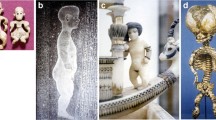Abstract
This article simplifies the radiologic diagnosis of skeletal dysplasia by first presenting an ordered approach for analysis of standard radiographs done for skeletal dysplasias. With that foundation, a more detailed discussion of three separate families of skeletal disorders follows. Similarities among dysplasia group members are discussed to provide a certain connectedness among dysplasias. The paper also elucidates the scientific basis behind the radiographic findings so that previously purely descriptive terms have the weight of understanding behind them.

















Similar content being viewed by others
References
Warman ML, Cormier-Daire V, Hall C et al (2011) Nosology and classification of genetic skeletal disorders: 2010 revision. Am J Med Genet A 155A:943–968
Lachman RS (2007) Taybi and Lachman's radiology of syndromes, metabolic disorders and skeletal dysplasias, 5th edn. Mosby, Philadelphia
Dwek JR, Lachman R (2019) Skeletal dysplasias and selected chromosomal disorders. In: Coley BD (ed) Caffey's pediatric diagnostic imaging. Elsevier, Philadelphia, pp 1258–1260
Offiah AC, Hall CM (2003) Radiological diagnosis of the constitutional disorders of bone. As easy as A, B, C? Pediatr Radiol 33:153–161
National Center for Biotechnology Information, U.S. Library of Medicine (2019) Online Mendelian Inheritance in Man (OMIM) database. https://www.ncbi.nlm.nih.gov/omim. Accessed 9 Sept 2019
Bonaventure J, Rousseau F, Legeai-Mallet L et al (1996) Common mutations in the fibroblast growth factor receptor 3 (FGFR 3) gene account for achondroplasia, hypochondroplasia, and thanatophoric dwarfism. Am J Med Genet 63:148–154
Ornitz DM, Legeai-Mallet L (2016) Achondroplasia: development, pathogenesis, and therapy. Dev Dyn 246:291–309
Vajo Z, Francomano CA, Wilkin DJ (2000) The molecular and genetic basis of fibroblast growth factor receptor 3 disorders: the achondroplasia family of skeletal dysplasias, Muenke craniosynostosis, and Crouzon syndrome with acanthosis nigricans. Endocr Rev 21:23–39
Sargar KM, Singh AK, Kao SC (2017) Imaging of skeletal disorders caused by fibroblast growth factor receptor gene mutations. Radiographics 37:1813–1830
Superti-Furga A, Hastbacka J, Wilcox WR et al (1996) Achondrogenesis type IB is caused by mutations in the diastrophic dysplasia sulphate transporter gene. Nat Genet 12:100–102
Superti-Furga A, Hastbacka J, Rossi A et al (1996) A family of chondrodysplasias caused by mutations in the diastrophic dysplasia sulfate transporter gene and associated with impaired sulfation of proteoglycans. Ann N Y Acad Sci 785:195–201
Spranger JW, Brill PW, Poznanski A (2002) Bone dysplasias: an atlas of genetic disorders of skeletal development, 2nd edn. Oxford University Press, New York
Skorzewska A, Grzymislawska M, Bruska M et al (2013) Ossification of the vertebral column in human foetuses: histological and computed tomography studies. Folia Morphol 72:230–238
Taybi H (1963) Diastrophic dwarfism. Radiology 80:1–10
Wilson DW, Chrispin AR, Carter CO (1969) Diastrophic dwarfism. Arch Dis Child 44:48–58
Sillence D, Worthington S, Dixon J et al (1997) Atelosteogenesis syndromes: a review, with comments on their pathogenesis. Pediatr Radiol 27:388–396
Kumar R, Guinto FC Jr, Madewell JE et al (1988) The vertebral body: radiographic configurations in various congenital and acquired disorders. Radiographics 8:455–485
Labrom RD (2007) Growth and maturation of the spine from birth to adolescence. J Bone Joint Surg Am 89:3–7
Woo TD, Tony G, Charran A et al (2018) Radiographic morphology of normal ring apophyses in the immature cervical spine. Skelet Radiol 47:1221–1228
Author information
Authors and Affiliations
Corresponding author
Ethics declarations
Conflicts of interest
None
Additional information
Publisher’s note
Springer Nature remains neutral with regard to jurisdictional claims in published maps and institutional affiliations.
Rights and permissions
About this article
Cite this article
Dwek, J.R. A framework for the radiologic diagnosis of skeletal dysplasias and syndromes as revealed by molecular genetics. Pediatr Radiol 49, 1576–1586 (2019). https://doi.org/10.1007/s00247-019-04545-8
Received:
Revised:
Accepted:
Published:
Issue Date:
DOI: https://doi.org/10.1007/s00247-019-04545-8




